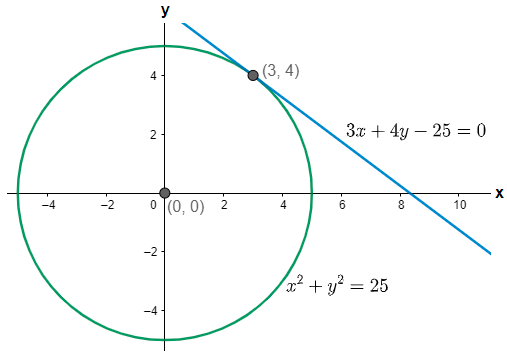
Consider the circle of radius 5 centered at (0, 0), how do you find an equation of the line tangent to the circle at the point (3, 4)?
Answer
509.4k+ views
Hint: Write the standard equation of the circle given as ${{\left( x-a \right)}^{2}}+{{\left( y-b \right)}^{2}}={{r}^{2}}$ where (a, b) is the coordinate of the center of the circle and r is radius of the circle. Substitute the given values to get the equation of the circle. Now, differentiate the obtained equation with respect to x and find the value of $\dfrac{dy}{dx}$ at (3, 4) which is the slope of the tangent. Finally, write the equation of the tangent line as $\left( y-{{y}_{1}} \right)=\dfrac{dy}{dx}\left( x-{{x}_{1}} \right)$ and simplify it to get the answer. Here, $\left( {{x}_{1}},{{y}_{1}} \right)=\left( 3,4 \right)$.
Complete step-by-step answer:
Here we have been provided with a circle of radius 5 units and whose center lies on the origin. We are asked to find the equation of a tangent line touching the circle at the point (3, 4).
Now, we know that the equation of a circle in standard form is given as ${{\left( x-a \right)}^{2}}+{{\left( y-b \right)}^{2}}={{r}^{2}}$ where (a, b) is the coordinate of the center of the circle and r is radius of the circle. Since, the center lies on the origin and radius is 5 units so we have (a, b) = (0, 0) and r = 5. Substituting the values in the equation of the circle we get,
$\begin{align}
& \Rightarrow {{\left( x \right)}^{2}}+{{\left( y \right)}^{2}}={{5}^{2}} \\
& \Rightarrow {{x}^{2}}+{{y}^{2}}=25 \\
\end{align}$
Now, we need to find the slope of the tangent at point (3, 4), so differentiating the above equation with respect to x we get,
$\Rightarrow \dfrac{d\left( {{x}^{2}} \right)}{dx}+\dfrac{d\left( {{y}^{2}} \right)}{dx}=\dfrac{d\left( 25 \right)}{dx}$
We know that the derivative of a constant is 0. Also using the chain rule of derivative to differentiate ${{y}^{2}}$ we get,
$\begin{align}
& \Rightarrow 2x+2y\dfrac{dy}{dx}=0 \\
& \Rightarrow \dfrac{dy}{dx}=\dfrac{-x}{y} \\
\end{align}$
Therefore at point (3, 4) we have the slope of tangent given as: -
$\begin{align}
& \Rightarrow 2x+2y\dfrac{dy}{dx}=0 \\
& \Rightarrow \dfrac{dy}{dx}=\dfrac{-3}{4} \\
\end{align}$
We know that the equation of a line passing through the point $\left( {{x}_{1}},{{y}_{1}} \right)$ and having slope $\dfrac{dy}{dx}$ is given as $\left( y-{{y}_{1}} \right)=\dfrac{dy}{dx}\left( x-{{x}_{1}} \right)$, so we get,
$\Rightarrow \left( y-4 \right)=\dfrac{-3}{4}\left( x-3 \right)$
On simplifying we get,
\[\begin{align}
& \Rightarrow 4y-16=-3x+9 \\
& \therefore 3x+4y-25=0 \\
\end{align}\]
Hence, the above linear equation is the equation of the required tangent.

Note: Remember the equations of a circle in different forms like standard form, general form, polar form etc. An important form of a circle is given as ${{x}^{2}}+{{y}^{2}}+2gx+2fy+c=0$ where $\left( -g,-f \right)$ is the center of the circle and $r=\sqrt{{{g}^{2}}+{{f}^{2}}-c}$ is the radius. Remember the basic rules of derivatives like the product rule, chain rule, $\dfrac{u}{v}$ rule etc. as they are frequently used in coordinate geometry and calculus.
Complete step-by-step answer:
Here we have been provided with a circle of radius 5 units and whose center lies on the origin. We are asked to find the equation of a tangent line touching the circle at the point (3, 4).
Now, we know that the equation of a circle in standard form is given as ${{\left( x-a \right)}^{2}}+{{\left( y-b \right)}^{2}}={{r}^{2}}$ where (a, b) is the coordinate of the center of the circle and r is radius of the circle. Since, the center lies on the origin and radius is 5 units so we have (a, b) = (0, 0) and r = 5. Substituting the values in the equation of the circle we get,
$\begin{align}
& \Rightarrow {{\left( x \right)}^{2}}+{{\left( y \right)}^{2}}={{5}^{2}} \\
& \Rightarrow {{x}^{2}}+{{y}^{2}}=25 \\
\end{align}$
Now, we need to find the slope of the tangent at point (3, 4), so differentiating the above equation with respect to x we get,
$\Rightarrow \dfrac{d\left( {{x}^{2}} \right)}{dx}+\dfrac{d\left( {{y}^{2}} \right)}{dx}=\dfrac{d\left( 25 \right)}{dx}$
We know that the derivative of a constant is 0. Also using the chain rule of derivative to differentiate ${{y}^{2}}$ we get,
$\begin{align}
& \Rightarrow 2x+2y\dfrac{dy}{dx}=0 \\
& \Rightarrow \dfrac{dy}{dx}=\dfrac{-x}{y} \\
\end{align}$
Therefore at point (3, 4) we have the slope of tangent given as: -
$\begin{align}
& \Rightarrow 2x+2y\dfrac{dy}{dx}=0 \\
& \Rightarrow \dfrac{dy}{dx}=\dfrac{-3}{4} \\
\end{align}$
We know that the equation of a line passing through the point $\left( {{x}_{1}},{{y}_{1}} \right)$ and having slope $\dfrac{dy}{dx}$ is given as $\left( y-{{y}_{1}} \right)=\dfrac{dy}{dx}\left( x-{{x}_{1}} \right)$, so we get,
$\Rightarrow \left( y-4 \right)=\dfrac{-3}{4}\left( x-3 \right)$
On simplifying we get,
\[\begin{align}
& \Rightarrow 4y-16=-3x+9 \\
& \therefore 3x+4y-25=0 \\
\end{align}\]
Hence, the above linear equation is the equation of the required tangent.

Note: Remember the equations of a circle in different forms like standard form, general form, polar form etc. An important form of a circle is given as ${{x}^{2}}+{{y}^{2}}+2gx+2fy+c=0$ where $\left( -g,-f \right)$ is the center of the circle and $r=\sqrt{{{g}^{2}}+{{f}^{2}}-c}$ is the radius. Remember the basic rules of derivatives like the product rule, chain rule, $\dfrac{u}{v}$ rule etc. as they are frequently used in coordinate geometry and calculus.
Recently Updated Pages
Master Class 8 Maths: Engaging Questions & Answers for Success

Class 8 Question and Answer - Your Ultimate Solutions Guide

Master Class 7 Maths: Engaging Questions & Answers for Success

Class 7 Question and Answer - Your Ultimate Solutions Guide

Master Class 6 Maths: Engaging Questions & Answers for Success

Class 6 Question and Answer - Your Ultimate Solutions Guide

Trending doubts
What is meant by exothermic and endothermic reactions class 11 chemistry CBSE

Which animal has three hearts class 11 biology CBSE

10 examples of friction in our daily life

One Metric ton is equal to kg A 10000 B 1000 C 100 class 11 physics CBSE

1 Quintal is equal to a 110 kg b 10 kg c 100kg d 1000 class 11 physics CBSE

Difference Between Prokaryotic Cells and Eukaryotic Cells




